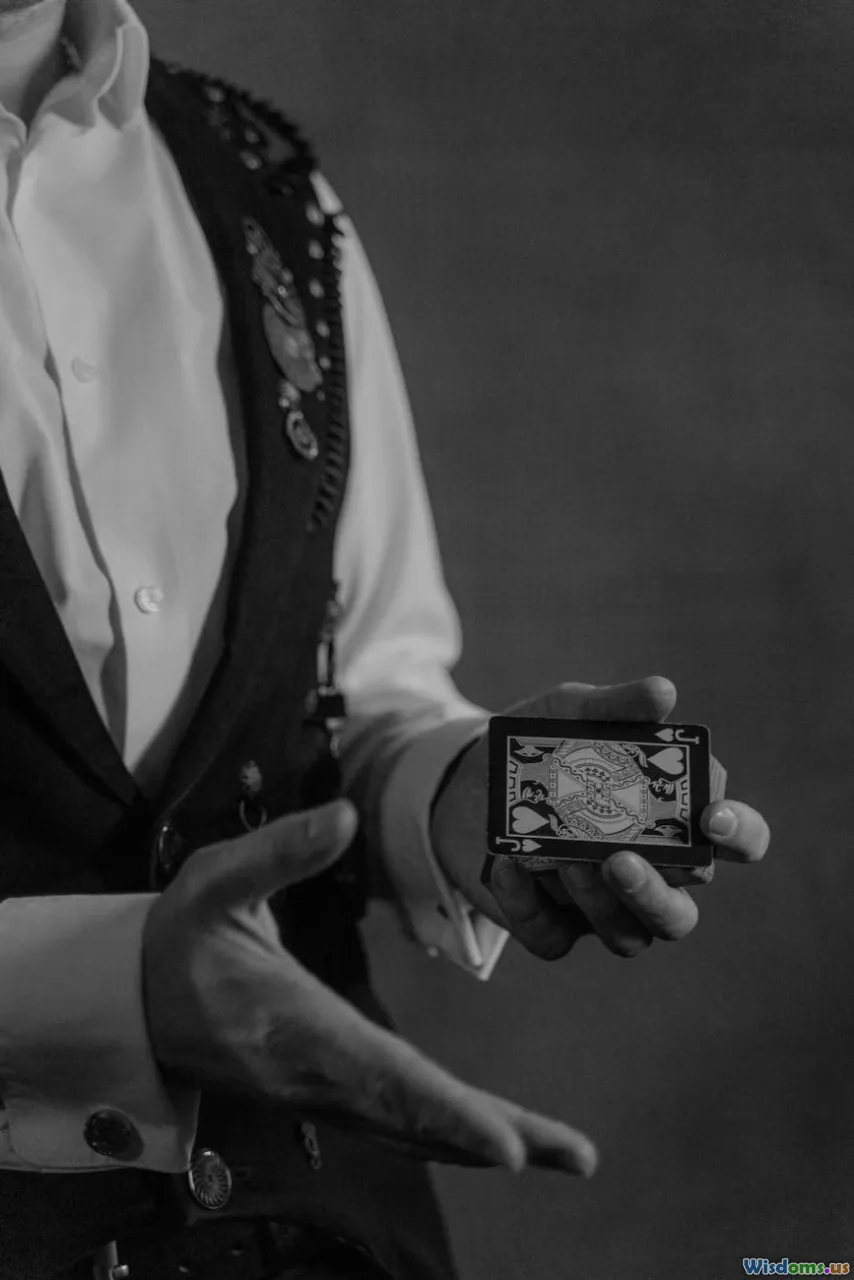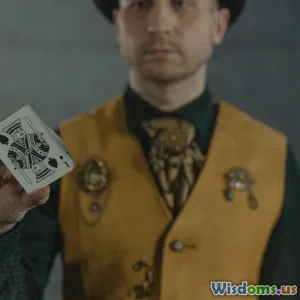
Mentalism Explained The Secrets Behind Mind Reading Magic
18 min read Explore the fascinating world of mentalism and uncover the secrets behind mind reading magic tricks. (0 Reviews)
Mentalism Explained: The Secrets Behind Mind Reading Magic
Many people have witnessed what appears to be real mind reading, either live, on television, or via viral online clips. An illusionist appears to read an audience member's innermost thoughts, predict impossible outcomes, or even extract private information. This uncanny demonstration is the heart of mentalism—an art that fuses psychology, suggestion, misdirection, sleight of hand, and a profound understanding of human nature. But how does it really work? And what sets mentalism apart from ordinary magic?
This article guides you behind the velvet curtain, revealing the secret tools, historic influences, and real psychological principles underpinning the mysterious craft of mind reading magic.
What Is Mentalism? The Art and Its Mystique

Mentalism is a performing art wherein the practitioner, commonly referred to as a mentalist, appears to exhibit extraordinary mental powers. Unlike traditional magicians who produce rabbits from hats or perform card tricks, mentalists operate in the realm of the mind. Their demonstrations seem to include:
- Telepathy (reading thoughts)
- Clairvoyance (gaining knowledge from occult means)
- Precognition (predicting the future)
- Psychokinesis (moving objects with the mind)
- Super memory feats
Historically, mentalism evolved alongside traditional magic. As early as the mid-19th century, shows combining hypnosis, seances, and "second sight" attracted thousands. Performers like The Davenport Brothers and Anna Eva Fay cleverly merged illusion with the language of spiritualism, establishing the ground for the mind reading acts we see today. Over the decades, mentalism was refined, particularly by artists like Dunninger, Kreskin, and, more recently, Derren Brown.
Mentalism differentiates itself from other magic forms with its immersive narrative—performances are more conversational and psychological. The performer often adopts the persona of someone with keen intuition or psychological prowess rather than labeling themselves as a "wizard" or magician. For many, this leads to the blurring of lines between entertainment and the real demonstration of supernatural abilities.
Psychological Principles in Mind Reading

While some claim real psychic skills, professional mentalists openly acknowledge the role that psychological techniques play in their art. Let's break down several key psychological principles used in mind reading acts:
1. Cold Reading
This is the bread and butter of mentalists. Cold reading involves extracting information subtly from people's body language, tone of voice, clothing, and reactions. By making high-probability guesses and observing how a person responds, the mentalist can refine their guesses and create the illusion of supernatural insight.
Example: When a mentalist says, "I'm sensing someone close to you—a family member has been worrying you," most people can relate to this, regardless of personal circumstance. The mentalist adjusts their next statement based on the audience member's reaction.
2. The Power of Suggestion
Mentalists excel at planting ideas in a person's mind through subtle suggestion. By carefully wording statements or questions, the performer influences the volunteer's decisions, often making it appear as though the mentalist has predicted or divined a secret thought.
Example: In psychological forcing, a mentalist may influence a person to choose a particular card, image, or word, through nonverbal cues and phrasing such as, "Just picture the first object that pops into your mind—don't overthink it, keep it simple."
3. Reading Micro-Expressions
Inspired by behavioral psychology, mentalists train themselves to observe micro-expressions—fleeting, involuntary facial cues that reveal true feelings. This skill, honed through years of practice, helps mentalists gauge reactions rapidly and adjust their performance.
4. The Barnum Effect (Forer Effect)
This refers to the tendency of people to believe vague, general statements as highly accurate for themselves—much like horoscopes. Mentalists exploit this effect by offering statements that "fit all," yet seem deeply intimate.
Fact: Psychologist Bertram Forer demonstrated this by giving subjects the same personality assessment; most rated its accuracy as high, even though their statements were identical.
The Sleight of Mind: Classic Mind Reading Tricks Explained

What appears as lore or extrasensory perception in a mentalist's act is often based on clever, methodical techniques. Here are some of the most enduring and mystifying methods mentalists use:
The Center Tear
A small slip of paper is torn after someone writes down a private thought. Inexpert eyes see nothing; the mentalist, however, catches a glimpse of the writing during the process. When they later "reveal" the thought, it feels miraculous. This method combines manual dexterity with misdirection so that the audience never notices the crucial moment.
The One Ahead Principle
This principle requires secretly obtaining information—often early in the trick—that provides the answer to what seems like an impossible prediction later. As each subsequent round plays out, the mentalist "stays one step ahead," consistently revealing information they already know.
The Book Test
Among mentalists' favorites is the book test, where a person picks any word from a borrowed book and the performer eerily names or writes it. This effect is often engineered through prepared or gimmicked books, secret cues, memorization, or guiding the spectator to a known page number using a force technique.
Dual Reality
A subtle but powerful trick: the spectator and the audience experience two different versions of the same effect. What feels like a random or freely chosen action to a participant is actually restricted by a method the audience can't detect, creating an extra layer of mystery.
Misdirection: The True Secret Weapon

No discussion of mentalism can ignore misdirection, the science of manipulating audience attention. Mastery of misdirection is what separates skilled mentalists from the amateurs. Darren Brown, for example, choreographs his performances so that the narrative and emotional content lead spectators to focus on the wrong details—while the secret moves occur right before their eyes.
How Misdirection Works
- Visual: Guiding the sightline of an audience to hands, faces, or props.
- Auditory: Using sound, laughter, or linguistic cues to obscure crucial moments.
- Psychological: Engaging different senses and emotions to distract conscious and unconscious processing.
A powerful instance of misdirection is when a mentalist engages a participant in an emotionally charged story or confuses them with rapid-fire choices and questions. In these distractions, subtle secret actions are performed, and nobody is the wiser.
Example: During a 'pick a card' effect, the performer may make an overt physical movement or tell an engaging anecdote as they switch, palm, or mark the card.
Psychological Force and Suggestion—How Do They Work?

Forcing is among the most baffling skills in any mentalist’s toolbox—the process where a person believes they made a free selection, while the performer secretly guided them to exactly what was needed for the trick.
- Classic Card Force: Techniques such as the "cross-cut force" allow the mentalist to seemingly let a person cut and pick any card, when in fact the card was always known or planted in advance.
- Equivoque (Magician's Choice): A mentalist gives outs based on every possible outcome: "Do you want to keep or discard this card?" The outcome seems participant-driven but is always curated to ensure the preferred result.
- Linguistic Forces: Subtle phrasing or psychological clues embedded in speech influence seemingly free decisions. A phrase like "Try not to think of the Queen of Hearts" paradoxically makes the card stick in the mind.
These approaches illustrate the dominance of psychological shaping in mentalism. While the audience believes in free will, the experienced mentalist is tracking, nudging, and controlling every choice.
The Science Behind the Illusions

While many believe mind reading is mystical, much of it rests on well-researched aspects of human perception and cognition. Cognitive science sheds light on why mentalism is so convincing.
The Limits of Human Attention
We can't pay attention to everything at once. Research in cognitive psychology reveals inattentional blindness: when we’re engrossed in one task (like listening to a compelling story), we simply overlook even major events.
Memory Manipulation
Human memory is highly reconstructive. Mentalists capitalize on this by subtly altering details or suggesting information, leading audiences to literally misremember what happened.
Pattern Recognition and Expectation
Our brains seek out patterns and consistency; this is how a well-timed "coincidence" or revelation feels destined, even when it’s been expertly manipulated behind the scenes. This need to find order in chaos is precisely what mentalists exploit, converting calculated setups into apparent miracles.
Famed Masters of Mentalism and Their Contributions

Several legendary figures have shaped the landscape of mentalism. Their unique approaches and groundbreaking acts continue to influence modern performers worldwide.
- Dunninger: One of America’s premier mentalists, he rivaled the popularity of magicians in the 1940s and was a pioneer of radio mind reading.
- The Amazing Kreskin: Known for his uncanny predictions and memory stunts, Kreskin captured the public’s imagination on TV in the 70s and 80s.
- Uri Geller: Famous (and controversial) for his purported abilities to bend spoons and read minds, Geller blurred the lines between show and supposed psi phenomena.
- Derren Brown: Today's master craftsman, Brown has popularized psychological illusionism; he often explains, at least partially, the real psychological principles at work as part of his act.
Each built upon prior traditions, taking advantage of ever-expanding public understanding of psychology, suggestion, and misdirection.
Ethical Boundaries: When Is Mind Reading Too Much?

Because of its power to influence, inspire, and even manipulate, mentalism has always been surrounded by ethical considerations.
- Disclosure: Most reputable performers present their skills as "psychological entertainment" rather than genuine psychic gifts, to avoid misleading the vulnerable.
- Consent: It’s vital that participants are aware (even subtly) that they’re involved in a trick, not covert hypnosis or genuine clinical psychology.
- Respect for Privacy: Some effects can skirt the line of what’s appropriate, especially if public embarrassment or disclosure of private thoughts is involved. Higher standards protect both performer and audience.
Professional organizations, like the Psychic Entertainers Association, promote ethical guidelines to keep the art form respectful, entertaining, and psychologically safe.
Can Anyone Learn Mind Reading Magic?

Absolutely! While becoming a master mentalist takes years of diligent practice, anyone can begin learning and appreciating the basics. Here's a structured approach if you’re curious:
Step 1: Study the Foundations
There are numerous classic texts, such as "13 Steps To Mentalism" by Tony Corinda and "Practical Mental Magic" by Theodore Annemann. These works systematically reveal the psychological and sleight-of-hand techniques mentalists rely upon.
Step 2: Practice Observation
Hone your powers of observation. People-watching is invaluable. Note micro-expressions, hesitation, and verbal clues—skills crucial to any mind reader.
Step 3: Develop Your Charisma
Mentalism thrives on belief and stage presence. Practice storytelling, confidence, and delivery. Your results hinge not just on trick methods but the persona you present to your audience.
Step 4: Learn Sleight of Hand and Forcing
Pick up some basic sleight of hand; the French Drop or the equivoque can be learned from books, videos, or in-person classes.
Step 5: Ethics and Responsibility
Never present your skills as supernatural unless for entertainment. Manipulation can be harmful if abused outside a performance context.
Mentalism vs. Magic: What Sets Them Apart?

The line dividing magic and mentalism can seem thin, but there are critical distinctions:
- Premise: Magic relies on impossible physical feats or visual illusions. Mentalism simulates real psychic or psychological phenomena.
- Structure: Magic tricks often have a clear secret move (like palming a card); mentalism relies on accumulated subtlety, psychology, and believability.
- Presentation: Mentalists act as facilitators of genuine mystery or psychological insight, never as sorcerers or tricksters.
This distinction is crucial: the theater of mentalism asks “what if someone really could read your mind?”—a uniquely personal mystery.
The allure of mentalism stems from its blurring of the borders between reality, psychology, and performance. What happens next time someone claims to read your mind? Perhaps you’ll watch with a more perceptive eye, recognizing both the remarkable psychology at work and the air of mystery that ensures mentalism remains endlessly intriguing.
Rate the Post
User Reviews
Popular Posts
















